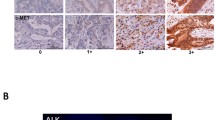Abstract
Purpose
To analyze the expression of c-Met, and to investigate correlations between the expression of c-Met, clinicopathologic variables, and survival in patients undergoing curative surgery followed by adjuvant chemoradiotherapy for extrahepatic bile duct (EHBD) cancer.
Methods
Ninety EHBD cancer patients who underwent curative resection followed by adjuvant chemoradiotherapy were enrolled. Expression of c-Met was assessed with immunohistochemical staining on tissue microarray. The correlation between clinicopathologic variables and survival outcomes was evaluated using Kaplan–Meier method and Cox proportional hazard model.
Results
On univariate analysis, 66 patients (76.7 %) showed c-Met expression. c-Met expression had a significant impact on 5-year overall survival (OS) (43.0 % in c-Met(+) vs. 25.0 % in c-Met(−), p = 0.0324), but not on loco-regional relapse-free survival or distant metastasis-free survival (DMFS). However, on multivariate analysis incorporating tumor location and nodal involvement, survival difference was not maintained (p = 0.2940). Tumor location was the only independent prognostic factor predicting OS (p = 0.0089). Hilar location tumors, nodal involvement, and poorly differentiated tumors were all identified as independent prognostic factors predicting inferior DMFS (p = 0.0030, 0.0013, and 0.0037, respectively).
Conclusions
This study showed that c-Met expression was not associated with survival outcomes in EHBD cancer patients undergoing curative resection followed by adjuvant chemoradiotherapy. Further studies are needed to fully elucidate the prognostic value of c-Met expression in these patients.


Similar content being viewed by others
References
Khan SA, Thomas HC, Davidson BR, Taylor-Robinson SD. Cholangiocarcinoma. Lancet. 2005;366(9493):1303–14. doi:10.1016/S0140-6736(05)67530-7.
Socoteanu MP, Mott F, Alpini G, Frankel AE. c-Met targeted therapy of cholangiocarcinoma. World J Gastroenterol. 2008;14(19):2990–4.
Yoshikawa D, Ojima H, Iwasaki M, Hiraoka N, Kosuge T, Kasai S, et al. Clinicopathological and prognostic significance of EGFR, VEGF, and HER2 expression in cholangiocarcinoma. Br J Cancer. 2008;98(2):418–25. doi:10.1038/sj.bjc.6604129.
Huang XY, Ke AW, Shi GM, Ding ZB, Devbhandari RP, Gu FM, et al. Overexpression of CD151 as an adverse marker for intrahepatic cholangiocarcinoma patients. Cancer. 2010;116(23):5440–51. doi:10.1002/cncr.25485.
Blumenschein GR Jr, Mills GB, Gonzalez-Angulo AM. Targeting the hepatocyte growth factor-cMET axis in cancer therapy. J Clin Oncol. 2012;30(26):3287–96. doi:10.1200/JCO.2011.40.3774.
Kim CH, Koh YW, Han JH, Kim JW, Lee JS, Baek SJ, et al. c-Met expression as an indicator of survival outcome in patients with oral tongue carcinoma. Head Neck. 2010;32(12):1655–64. doi:10.1002/hed.21383.
Eder JP, Vande Woude GF, Boerner SA, LoRusso PM. Novel therapeutic inhibitors of the c-Met signaling pathway in cancer. Clin Cancer Res. 2009;15(7):2207–14. doi:10.1158/1078-0432.CCR-08-1306.
Nakamura Y, Niki T, Goto A, Morikawa T, Miyazawa K, Nakajima J, et al. c-Met activation in lung adenocarcinoma tissues: an immunohistochemical analysis. Cancer Sci. 2007;98(7):1006–13. doi:10.1111/j.1349-7006.2007.00493.x.
Drebber U, Baldus SE, Nolden B, Grass G, Bollschweiler E, Dienes HP, et al. The overexpression of c-met as a prognostic indicator for gastric carcinoma compared to p53 and p21 nuclear accumulation. Oncol Rep. 2008;19(6):1477–83.
Herrera LJ, El-Hefnawy T, Queiroz de Oliveira PE, Raja S, Finkelstein S, Gooding W, et al. The HGF receptor c-Met is overexpressed in esophageal adenocarcinoma. Neoplasia. 2005;7(1):75–84. doi:10.1593/neo.04367.
Liu C, Park M, Tsao MS. Overexpression of c-met proto-oncogene but not epidermal growth factor receptor or c-erbB-2 in primary human colorectal carcinomas. Oncogene. 1992;7(1):181–5.
Suzuki K, Hayashi N, Yamada Y, Yoshihara H, Miyamoto Y, Ito Y, et al. Expression of the c-met protooncogene in human hepatocellular carcinoma. Hepatology. 1994;20(5):1231–6.
Terada T, Nakanuma Y, Sirica AE. Immunohistochemical demonstration of MET overexpression in human intrahepatic cholangiocarcinoma and in hepatolithiasis. Hum Pathol. 1998;29(2):175–80.
Hida Y, Morita T, Fujita M, Miyasaka Y, Horita S, Fujioka Y, et al. Clinical significance of hepatocyte growth factor and c-Met expression in extrahepatic biliary tract cancers. Oncol Rep. 1999;6(5):1051–6.
Aishima SI, Taguchi KI, Sugimachi K, Shimada M, Sugimachi K, Tsuneyoshi M. c-erbB-2 and c-Met expression relates to cholangiocarcinogenesis and progression of intrahepatic cholangiocarcinoma. Histopathology. 2002;40(3):269–78.
Nakazawa K, Dobashi Y, Suzuki S, Fujii H, Takeda Y, Ooi A. Amplification and overexpression of c-erbB-2, epidermal growth factor receptor, and c-met in biliary tract cancers. J Pathol. 2005;206(3):356–65. doi:10.1002/path.1779.
Miyamoto M, Ojima H, Iwasaki M, Shimizu H, Kokubu A, Hiraoka N, et al. Prognostic significance of overexpression of c-Met oncoprotein in cholangiocarcinoma. Br J Cancer. 2011;105(1):131–8. doi:10.1038/bjc.2011.199.
Chung JY, Hong SM, Choi BY, Cho H, Yu E, Hewitt SM. The expression of phospho-AKT, phospho-mTOR, and PTEN in extrahepatic cholangiocarcinoma. Clin Cancer Res. 2009;15(2):660–7. doi:10.1158/1078-0432.CCR-08-1084.
Han Y, Zhang W, Liu Y. Identification of hepatoma-derived growth factor as a potential prognostic and diagnostic marker for extrahepatic cholangiocarcinoma. World J Surg. 2013;37(10):2419–27. doi:10.1007/s00268-013-2132-4.
Kim K, Min HS, Chie EK, Jang JY, Kim SW, Han SW, et al. CD24 expression predicts distant metastasis in extrahepatic bile duct cancer. World J Gastroenterol. 2013;19(9):1438–43. doi:10.3748/wjg.v19.i9.1438.
Koh HK, Park HJ, Kim K, Chie EK, Min HS, Ha SW. Molecular biomarkers in extrahepatic bile duct cancer patients undergoing chemoradiotherapy for gross residual disease after surgery. Radiat Oncol J. 2012;30(4):197–204. doi:10.3857/roj.2012.30.4.197.
Uemura S, Kuramochi H, Higuchi R, Nakajima G, Yamamoto M. ERCC1 mRNA expression as a postoperative prognostic marker in extrahepatic bile duct cancer. Ann Surg Oncol. 2014. doi:10.1245/s10434-014-3726-2.
Endo K, Yoon BI, Pairojkul C, Demetris AJ, Sirica AE. ERBB-2 overexpression and cyclooxygenase-2 up-regulation in human cholangiocarcinoma and risk conditions. Hepatology. 2002;36(2):439–50. doi:10.1053/jhep.2002.34435.
Author information
Authors and Affiliations
Corresponding author
Ethics declarations
Informed consent
Informed consent was obtained from all individual participants included in the study.
Ethical approval
All procedures performed in studies involving human participants were in accordance with the ethical standards of the institutional and/or national research committee and with the 1964 Helsinki Declaration and its later amendments or comparable ethical standards.
Conflict of interest
The authors declare that they have no conflict of interest.
Rights and permissions
About this article
Cite this article
Park, H.J., Kim, K., Paik, J.H. et al. Is c-Met oncoprotein expression an adverse prognosticator in extrahepatic bile duct cancer treated with curative resection followed by adjuvant chemoradiotherapy?. Clin Transl Oncol 18, 625–631 (2016). https://doi.org/10.1007/s12094-015-1409-5
Received:
Accepted:
Published:
Issue Date:
DOI: https://doi.org/10.1007/s12094-015-1409-5




